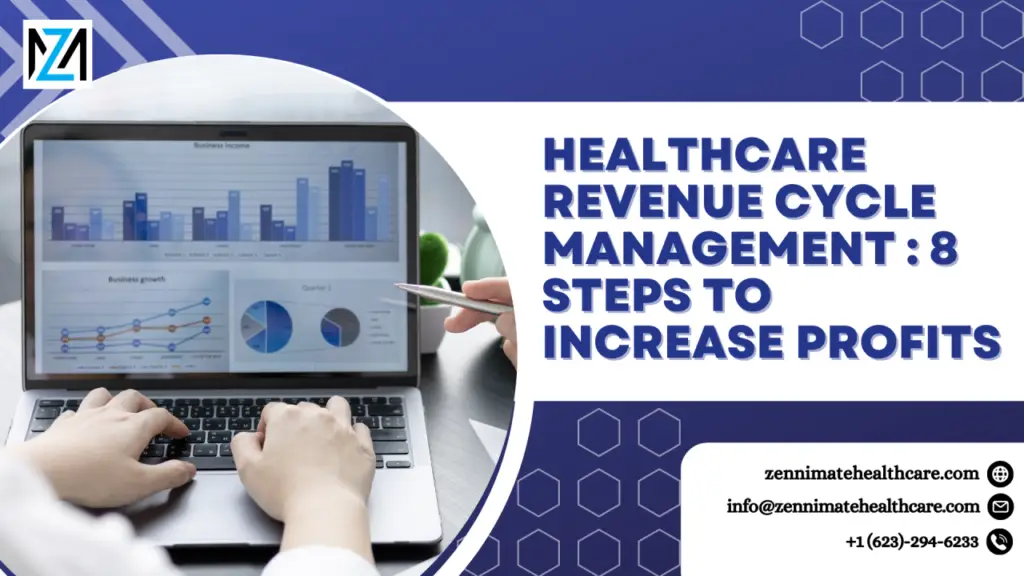Adding Profits to Your Healthcare Revenue Cycle Management (RCM)
In the complex world of healthcare, Revenue Cycle Management (RCM) in the USA plays a vital role in making sure that providers receive fair payment for their services. An optimized RCM process improves cash flow and boosts patient satisfaction.

Understanding Revenue Cycle Management
Revenue Cycle Management (RCM) includes all the administrative and clinical tasks that gather, manage, and collect patient revenue. Each step, from patient registration to final payment, plays a vital role in ensuring financial stability.
Key Benefits of Effective RCM
- Improved Cash Flow:Efficient RCM operations result in faster payments and fewer billing issues.
- Enhanced Patient Experience: Streamlined procedures lead to improved patient interactions and satisfaction.
- Increased Profitability: By cutting down on claim denials and boosting collections, healthcare businesses can significantly raise their revenue.
- Compliance and Reporting: Effective management ensures compliance with regulations and improves reporting accuracy.
Steps for Healthcare Revenue Cycle Management USA
1. Patient Registration
The RCM process starts with patient registration, where staff gather essential information. Accurate data entry at this stage is crucial for billing and processing claims.
- To improve, consider using electronic health records (EHR). Implement EHR systems to provide smooth data collecting.
- Personnel Training: Ensure that the personnel is properly taught to collect the relevant information.
2. Insurance Verification
Insurance verification entails validating a patient’s insurance status and benefits. This procedure helps to avoid refused claims owing to coverage concerns.
- Automate Verification: Use software solutions to automate the verification process, which will reduce manual mistakes.
- Create a checklist. Create a checklist with the relevant information needed for verification.
3: Coding.
Medical coding is the process of translating healthcare services into standardized billing codes. Accurate coding is required for proper compensation.
- Invest in training. Provide regular training to coding workers so that they may keep up to speed on coding standards.
- Use Coding Software. Implement coding software to reduce human mistakes and increase accuracy.
4: Charge Capture
Charge capture involves documenting all services provided to ensure no charges are missed. This step is essential for maximizing revenue.
- Implement charge-capture tools: Use electronic charge-capture tools to streamline the process and improve efficiency.
- Conduct frequent audits to verify that all services are appropriately captured.
5: Claim Submission
Following coding and charge capture, claims are sent to insurance companies for payment. Timely filing is essential for ensuring cash flow.
- Use e-claim submission: Electronic claims submission can expedite the process while reducing mistakes.
- Track Claims Status: Set up a system to track the status of claims so that any concerns can be addressed quickly.
6: Payment Posting.
Payment posting involves recording payments from insurers and patients. Accurate posting is essential for financial reports and reconciliation.
- Automate Posting: Use software to automate payment posting, which reduces manual labor.
- Frequent Reconciliation: Regularly reconcile the funds received with the claims submitted to identify any discrepancies.
7: Denial Management
Claims denials can greatly impact revenue. Effective denial management involves identifying, addressing, and appealing rejected claims.
- Analyze denials. Regularly examine denial patterns to determine fundamental reasons and take necessary action.
- Streamline the Appeals Process: Develop a systematic method to appeal refused claims to increase recovery rates.
8: Patient Collections
The final step in the RCM process is to collect payments directly from patients for their portion of the bill. Efficient patient collections are crucial for increasing revenue.
- Flexible Payment Options: Offer multiple payment options to enhance patient convenience.
- Clear Communication: Communicate billing information clearly to patients to reduce confusion and enhance collections.
Maximizing Profits with Effective RCM
A well-optimized revenue cycle can significantly enhance the profitability of healthcare companies. By focusing on each phase of the Healthcare Revenue Cycle Management USA process and implementing targeted improvement techniques, healthcare providers can maintain a steady cash flow and ensure their financial health.
How ZenniMate Healthcare Can Help.
ZenniMate Healthcare, a prominent medical billing firm, is committed to enhancing healthcare RCM by streamlining operations and maximizing reimbursements for providers.
- Expert Team: Our skilled billing professionals assure proper coding and fast claim submission.
- Advanced Technology: We use cutting-edge technology to automate and expedite certain RCM operations.
- Comprehensive Reporting: Our detailed reports help pinpoint areas that need improvement, boosting overall efficiency.
- Ongoing Support: We constantly support and train your employees, keeping them updated on best practices and industry developments.
Improving your healthcare revenue cycle management is critical for increasing earnings and safeguarding the financial health of your company. Understanding and improving each phase, as well as collaborating with professionals such as ZenniMate Healthcare, may help you improve your RCM processes, increase profitability, and ultimately improve patient happiness.

